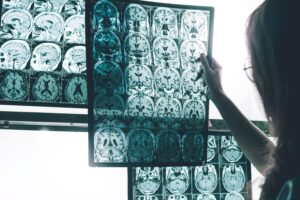Huntington’s disease (HD) is a rare inherited neurodegenerative disorder that impacts movement, language, and cognitive function. There is no known cure for the disease, which causes symptoms to worsen over time as patients lose striatal neurons. However, a new UCLA Health mouse model study demonstrated a potential connection between specific DNA-repair genes and the neurons damaged in Huntington’s disease. Read on for more insight into the study, which was published in the journal Cell and could pave the way for future HD treatments.
Unlocking the Misunderstood Huntington’s Disease Mechanism
Huntington’s disease is caused by a “genetic stutter” mutation. The mutation involves trinucleotide repeats, or “stutters.” The cytosine-adenine-guanine (CAG) chain is repeated in a gene called huntingtin. This repeat is an inherited mutation. Additionally, the more CAG repeats a person inherits, the earlier they are likely to experience disease onset. However, while the mutation is known to cause the disease, the actual mechanism — how the disease appears to selectively affect specific types of neurons, impacting specific functions — is poorly understood.
The new UCLA Health study, cited above, reveals an important clue: a distinct subset of mismatch repair genes, which may be key drivers of the disease’s assault on striatal neurons.
Key Observations in Huntington’s Disease Mouse Models
The UCLA research team worked with a mouse model of HD, which is bred to exhibit a remarkable 140 CAG repeats. The team members planned to genetically alter nine modifier genes derived from HD patients, including six mismatch repair genes, in the mouse model. The HD mouse model exhibits numerous key characteristics, including the dysregulation of the expression of thousands of genes in striatal neurons as well as a marked accumulation of clumps of mutant Huntingtin protein, which are a hallmark of HD pathology. These clumps progressively worsen over time, impacting both the striatal and cortical neurons.
After modifying the mismatch repair genes, the researchers observed something startling: the mice engineered without these genes, especially Msh3 and Pms1, exhibited far fewer gene expression deficits. This either partially or fully prevented the buildup of mutant Huntingtin clumps in the subjects’ brains. This sparked the team’s curiosity: could mismatch repair genes alter the disease process in humans, too?
Applying the Findings
Though the role of modifier genes in this application remains untested in patients, the mouse model studies are promising. Additionally, previous studies show that mismatch repair genes are linked to high levels of instability in the striatum, the brain region most vulnerable to HD symptoms. However, only a specific subset of repeats appears to expand beyond the inherited allele.
“These remarkable results demonstrate that a subset of mismatch repair genes is driving disease in vulnerable neurons because they confer the fastest rate of CAG repeat expansion in these neurons,” said Nan Wang, a co-first author in the study, adding, “Our study provides mechanistic links that help to bridge modifier genes from patients, mismatch repair gene driven repeat expansion, and selective neuronal vulnerability in HD.”
_____
The study could have numerous therapeutic implications for the treatment of HD. It shows that, ideally, targeting these mismatch repair genes could benefit multiple brain regions, including those with striatum or late-onset cortex pathologies. If applied in a therapeutic capacity, this could delay the onset or slow the progression of Huntington’s disease.
To study Huntington’s disease, Scantox Neuro offers three animal models: the R6/2 mouse model with about 120 CAG repeats, the zQ175DN-KI mouse model with about 180-220 CAG repeats, and the BACHD rat model with 97 alternating CAA/CAG repeats. All models can be used for treatment studies and evaluated for behavioral deficits as well as neuronal pathologies using biochemical and histological methods.
Scantox is the leading Nordic preclinical GLP-accredited contract research organization (CRO), delivering the highest grade of pharmacology and regulatory toxicology services since 1977. Scantox focuses on preclinical contract research services, supporting pharmaceutical and biotechnology companies with their drug development projects. Core competencies include explorative and efficacy studies, PK studies, general toxicology studies, local tolerance studies, wound healing studies, and vaccines. To learn more about our services and areas of study, please subscribe to our newsletter. And if you’re interested in partnering with us, please contact us online.











